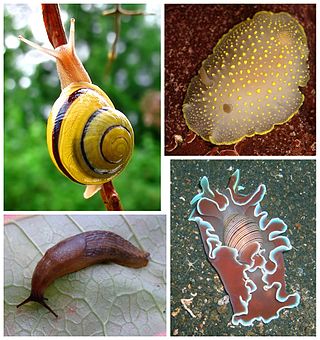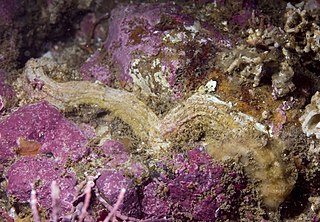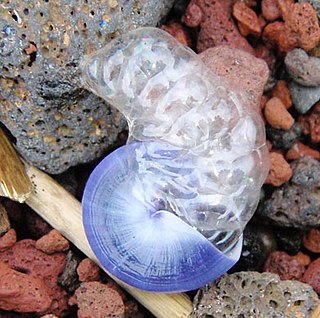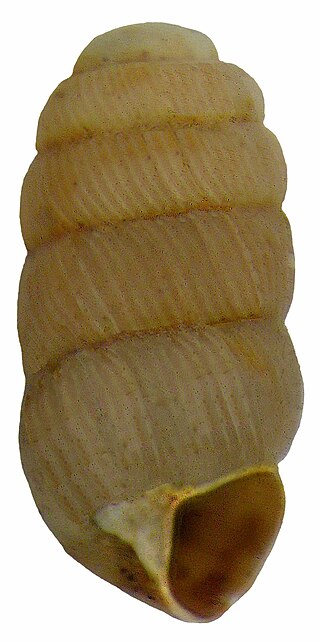
Sea slug is a common name for some marine invertebrates with varying levels of resemblance to terrestrial slugs. Most creatures known as sea slugs are gastropods, i.e. they are sea snails that, over evolutionary time, have either entirely lost their shells or have seemingly lost their shells due to having a significantly reduced or internal shell. The name "sea slug" is often applied to nudibranchs and a paraphyletic set of other marine gastropods without apparent shells.

Heterobranchia, the heterobranchs, is a taxonomic clade of snails and slugs, which includes marine, aquatic and terrestrial gastropod mollusks.

Caenogastropoda is a taxonomic subclass of molluscs in the class Gastropoda. It is a large diverse group which are mostly sea snails and other marine gastropod mollusks, but also includes some freshwater snails and some land snails. The subclass is the most diverse and ecologically successful of the gastropods.

Sorbeoconcha is a taxonomic clade of snails, i.e. gastropods, mainly marine species with gills and opercula, within the clade Caenogastropoda.

Littorinimorpha is a large order of snails, gastropods, consisting primarily of sea snails, but also including some freshwater snails and land snails.

Sea snail is a common name for slow-moving marine gastropod molluscs, usually with visible external shells, such as whelk or abalone. They share the taxonomic class Gastropoda with slugs, which are distinguished from snails primarily by the absence of a visible shell.

The Systellommatophora is a clade of primitive, air-breathing slugs, according to the taxonomy of the Gastropoda.

The Vermetidae, the worm snails or worm shells, are a taxonomic family of small to medium-sized sea snails, marine gastropod molluscs in the clade Littorinimorpha. The shells of species in the family Vermetidae are extremely irregular, and do not resemble the average snail shell, hence the common name "worm shells" or "worm snails".

Amathinidae, is a taxonomic family mostly consisting of small and minute sea snails, marine heterobranch gastropod molluscs or micromolluscs in the superfamily Pyramidelloidea.

Cylichnidae, common name the "chalice bubble snails" or "canoe bubble snails" is a family of sea snails or bubble snails, marine gastropod mollusks in the superfamily Cylichnoidea.

Neritimorpha is a clade of gastropod molluscs that contains around 2,000 extant species of sea snails, limpets, freshwater snails, land snails and slugs. This clade used to be known as the superorder Neritopsina.

Sigmurethra is a taxonomic category of air-breathing land snails and slugs, terrestrial pulmonate gastropod molluscs. This is an informal group which includes most land snails and slugs.

Haliotoidea is a superfamily of sea snails, marine gastropod mollusks in the subclass Vetigastropoda.

The Ptenoglossa is an informal taxonomic group of sea snails. This group was considered paraphyletic or polyphyletic by Ponder and Lindberg (1997) in their classification of gastropod molluscs.
Runcinoidea is a taxonomic superfamily or a clade Runcinaecea of sea slugs, marine gastropod mollusks in the order Runcinida
Tjaernoeia is a genus of sea snails, marine gastropod mollusks in the informal group Lower Heterobranchia.

Cylindrobulla is a genus of sea snails or bubble snails, marine gastropod mollusks in the clade Sacoglossa.

Hygrophila is a taxonomic superorder of air-breathing freshwater snails, aquatic pulmonate gastropod mollusks within the clade Panpulmonata.

Rostellariidae is a family of sea snails, marine gastropod molluscs in the clade Littorinimorpha.

After excluding groups not related, the informal group Sigmurethra has become the suborder Helicina, with the following infraorders and a collection of families with no superfamily:


















